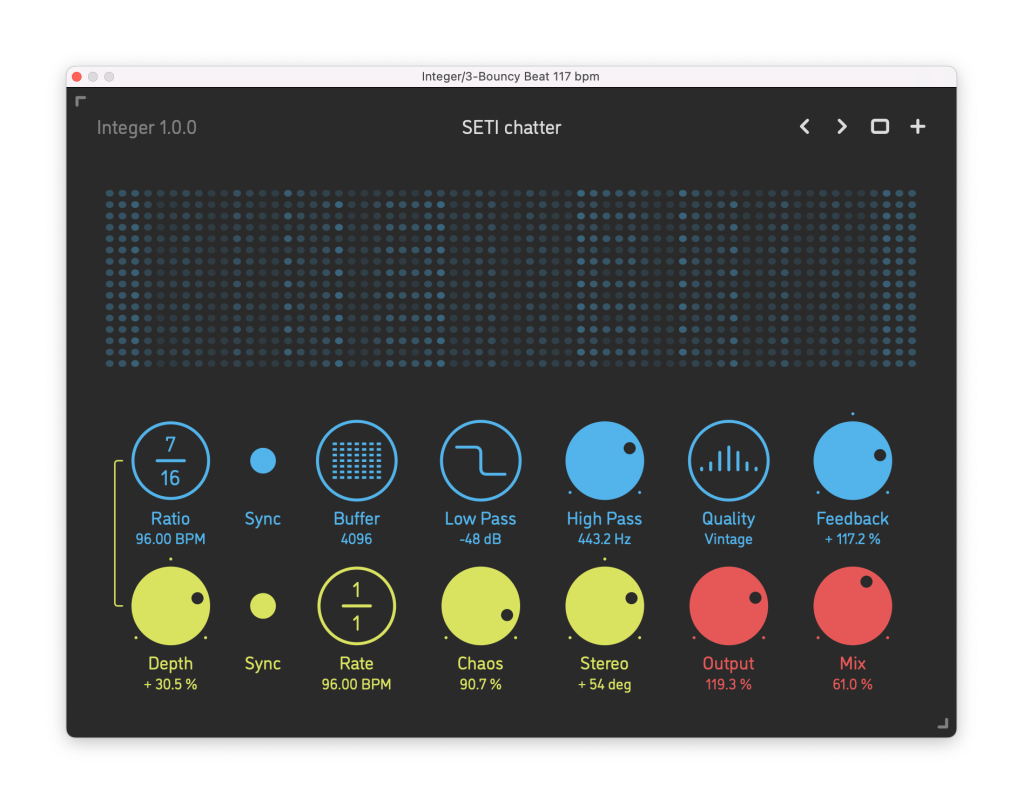Just when you think you can’t hear any new noises from a delay, along comes Sinevibes Integer, drawing on classic bucket brigade delays to create something retro and futuristic all at once. We’ve also got an extra CDM-exclusive preset bank to explore more.
The essence of Integer is a delay engine that adjusts the delay time by changing the internal sample clock. That’s how analog bucket brigade device (BBD) chips work, too, but this isn’t quite a model of a BBD delay – it’s a digital delay based on the same fundamental architectural ideas.
As with analog BBD delays, the signal fed through the delay buffer is fed back into the input in a loop, which in turn gives you not only delay effects but chorus, flanger, and other related descendants. Then Integer adds some twists. There’s an enormous clock range (from Hz to MHz), different buffer sizes, and quality modes, which translate to very different timbral characteristics. And you get tape-style pitch glides as you change the frequency.

Put those together, and you can get unusual pitched effects, lo-fi chatter, wild swoops, and sounds that range from really glitchy vintage digital to out-there futuristic sounds. (That is, this doesn’t always sound like delay hardware, and also doesn’t always sound like all the software trying to sound like that hardware.) There’s also a brick-wall limiter in the feedback loop, which means you can crank the feedback – and it has the range to match, with +/- 200% level. You can also push signal up against that limiter and use Integer to push dynamic level.
So Integer isn’t really just a normal delay. It’s a downsampler/crusher and a dynamic effect at the same time. It’s a deeply creative sound tool that covers the full range of what you’d expect a delay to do.

Integer isn’t really just a normal delay. It’s a downsampler/crusher and a dynamic effect at the same time.
It’s a little hard to conceptualize the combination of feedback loop, buffer size, and internal sample rate all together. The early build I got had just the bottom half of the UI. Then in the early beta process, Artemiy announced he had gone up to the Baltic Sea – and returned with a sea-inspired pattern of interlaced dots that perfectly visualize what’s going on internally. It makes this feel like a long-lost piece of classic digital delay hardware from a parallel universe.
As usual with Sinevibes, you get some carefully-chosen, color-coded parameters and just that. There are considered design decisions of what not to do, as opposed to the sprawling UIs you usually get. But the parameters that are there are clear, have big ranges, and then complete sine-wave modulation with sync. That directs the user to focus on modulation and experimenting with ranges, much as you would on a modular. In the case of Integer, this almost feels like multiple plug-ins in one, because of the different algorithms and ranges.
It makes this feel like a long-lost piece of classic digital delay hardware from a parallel universe.
There’s a lot in there:
- Digital-analog delay model with variable sample rate
- Wide clock range
- Wide delay range (0.1 ms – 1000 ms)
- Unsynced delay times, or tempo sync delays capable of some complex divisions (1-8 numerator / 1-64 denominator gives you eighth, dotted eight etc. but also… some complex fractions)
- One-pole lag filters on all continuous parameters – everything is silky smooth and you never hear a pop
- Modulation (which also has that same division scheme), also with a wide range (0.01 Hz – 10 Hz) and Chaos control
- Multiple quality algorithms for output: Vintage, Modern, Ideal
- Variable low-pass and high-pass filters on input
- Stereo spacing (-180 – 180) in feedback loop
- Bipolar feedback (-200 – 200%) capable of endless amplification (but brickwall-limited)
macOS 10.9+ / Windows 8.1+, AAX, VST3, Mac AU.
CDM presets for you
I spent an evening just making presets to try to capture the range of what I was getting – including some of the kind of strange but wonderful rubbery pitch sweeps I was getting that I’d tend to throw out with other plug-ins. Here, they take on a particular sound that’s not quite like other delays – it’s very Sinevibes, let’s say. I’ve found this useful, as ever since I’ve been calling up these presets while playing with production in ways I would tend not to do with other delays.
And the download:
Free CDM Integer Pack – Peter Kirn Signature Weirdo Edition*
*”It only gets MY stamp of approval as a weirdo if I get distracted for a while from whatever it was I was supposed to be doing!”
Examples
More sound examples by Artemiy for Sinevibes: